- Feijoa: A Delicious and Low-Maintenance Fruit
- Easy to Grow
- Delicious and Nutritious
- Low Maintenance
- Conclusion
- Choosing the Perfect Location for Your Feijoa Tree
- 1. Sunlight
- 2. Climate
- 3. Soil Quality
- 4. Wind Protection
- 5. Spacing
- 6. Accessible Water Source
- Planting Tips for Feijoa Trees
- Choose the Right Location
- Prepare the Soil
- Dig the Hole
- Plant the Tree
- Water and Mulch
- Staking
- Care and Maintenance
- Feijoa Tree Pruning: the Key to Healthy Growth
- Why Prune Feijoa Trees?
- When to Prune Feijoa Trees?
- How to Prune Feijoa Trees?
- Tools for Pruning Feijoa Trees
- Conclusion
- Soil and Fertilizer Requirements for Feijoa Trees
- Fertilizing Feijoa Trees
- Additional Tips
- Watering Feijoa Trees: Finding the Right Balance
- 1. Watering Frequency
- 2. Watering Amount
- 3. Deep Watering
- 4. Mulching
- 5. Monitoring Soil Moisture
- Protecting Feijoa Trees from Pests and Diseases
- Pests
- Diseases
- Harvesting and Storing Feijoa Fruits
- Feijoa Recipes: Delicious Ways to Enjoy Your Harvest
- 1. Feijoa Smoothie
- 2. Feijoa Jam
- 3. Feijoa Chutney
- 4. Feijoa Salad
- 5. Feijoa Crumble
- Q&A:
- What is feijoa and where does it originate from?
- Is it easy to grow feijoa?
- What are the care recommendations for growing feijoa?
- Can feijoa be grown in containers?
- When is the best time to plant feijoa?
- How long does it take for feijoa to bear fruit?
- What are some common pests and diseases that affect feijoa?
- Video: 5 ways to get your Feijoa or Pineapple guava to fruit in the desert!
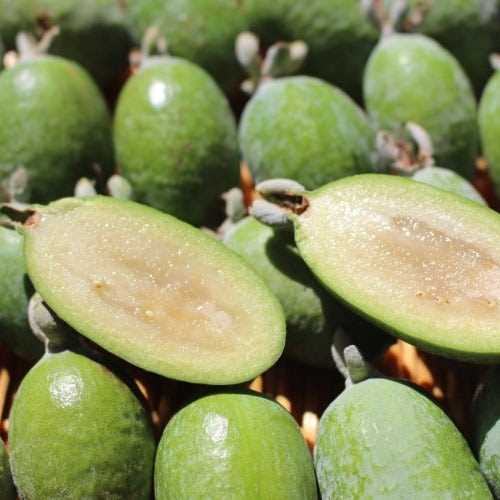
Growing feijoa, also known as pineapple guava, is a rewarding experience for any gardener. This evergreen shrub produces delicious and aromatic fruits that are a favorite among fruit lovers. Feijoa is native to South America but can be grown in many parts of the world with the right care and conditions.
One of the best things about feijoa is its easy care requirements. It can tolerate a wide range of soil types and pH levels, making it suitable for various garden settings. Feijoa also has excellent resistance to pests and diseases, reducing the need for chemical interventions.
To grow feijoa successfully, it’s essential to choose a sunny location with well-drained soil. Feijoa prefers full sun exposure to ensure proper fruit development. The soil should be fertile and rich in organic matter, which can be achieved by adding compost or well-rotted manure.
Feijoa plants should be watered regularly, especially during periods of drought. However, it’s important not to overwater as excessive moisture can lead to root rot. Applying a layer of mulch around the plants will help retain moisture and suppress weed growth. Feijoa is a relatively low-maintenance plant and requires minimal pruning. However, light pruning can be done in late winter or early spring to maintain a desired shape and improve air circulation.
In conclusion, feijoa is an excellent addition to any garden due to its delicious fruits and easy care requirements. With the right conditions and minimal maintenance, everyone can enjoy growing and harvesting their own feijoa fruits!
Feijoa: A Delicious and Low-Maintenance Fruit
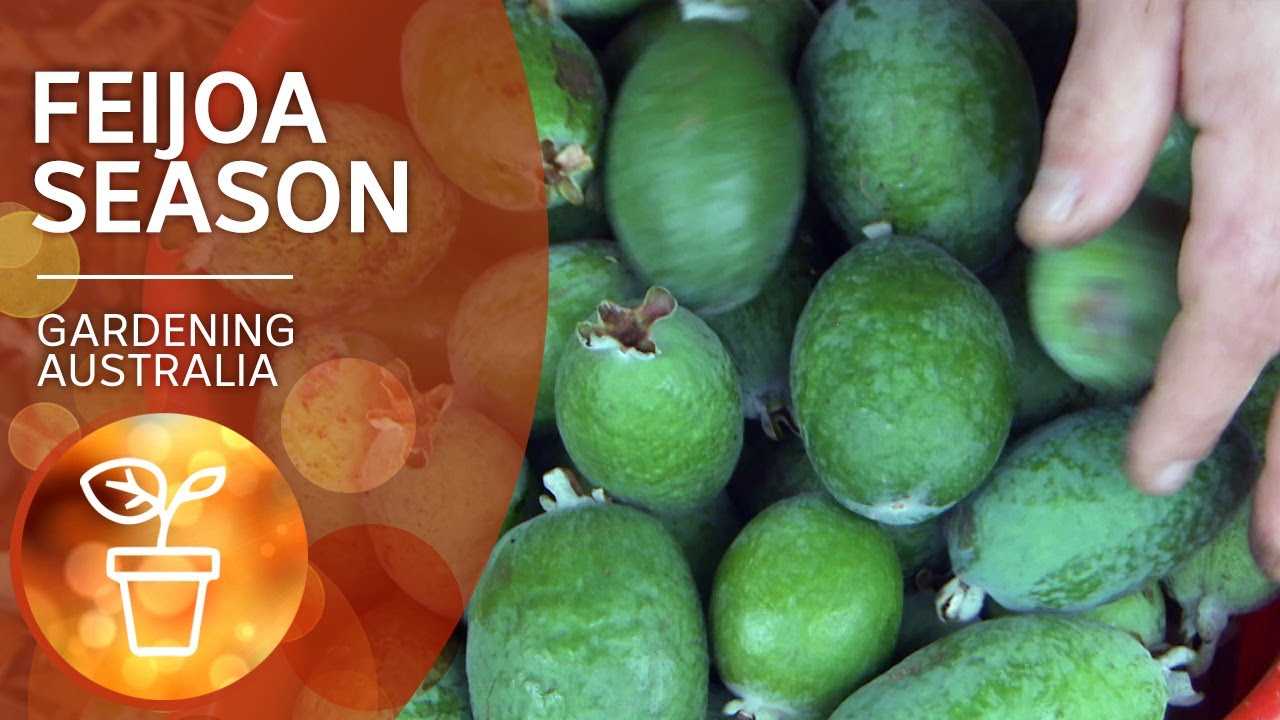

Feijoa, also known as pineapple guava, is a delicious and low-maintenance fruit that can be easily grown in your own backyard or garden. Originally from South America, feijoa is now widely cultivated and enjoyed in many parts of the world. With its unique taste and numerous health benefits, feijoa is a fruit worth including in your diet.
Easy to Grow
One of the great things about feijoa is its ability to thrive in various climates and soil conditions. Whether you live in a tropical or temperate region, feijoa can be successfully grown. It can tolerate both full sun and partial shade, making it suitable for a range of garden settings.
Feijoa plants are known for their adaptability and resilience. They are drought-tolerant and can survive minor neglect. However, regular watering and fertilizing can help ensure healthier and more productive plants.
Delicious and Nutritious
The fruit of the feijoa plant is highly aromatic and has a unique flavor profile that is often described as a blend of pineapple, guava, and mint. It has a sweet and tangy taste with a slightly grainy texture. Feijoa is commonly eaten raw, either by simply cutting it in half and scooping out the flesh with a spoon or by peeling and slicing it.
In addition to its delicious taste, feijoa is packed with nutrients. It is a good source of vitamin C, dietary fiber, and minerals such as potassium and magnesium. Feijoa also contains antioxidants that help fight inflammation and protect against oxidative stress.
Low Maintenance
Feijoa plants require minimal care, making them an ideal choice for both experienced and novice gardeners. They are generally pest-resistant and do not require frequent pruning. However, some light pruning can help maintain a compact and tidy plant.
Feijoa trees can start producing fruit within 2-3 years of planting, and they can continue to bear fruit for several decades. The fruit ripens in late autumn or early winter, providing a welcome harvest when other fruits are scarce.
Conclusion
Feijoa is a delicious and low-maintenance fruit that can be easily grown in your own garden. With its unique taste and numerous health benefits, feijoa is a versatile fruit that can be enjoyed in a variety of ways. So whether you are an experienced gardener or a novice, consider adding feijoa to your backyard or garden for a flavorsome and rewarding experience.
Choosing the Perfect Location for Your Feijoa Tree
When it comes to growing feijoa trees, choosing the right location is essential for their success. Feijoa trees thrive in specific climate conditions and require adequate sunlight and soil quality. Here are some important factors to consider when selecting the perfect location for your feijoa tree:
1. Sunlight
Feijoa trees love sunlight, so it is crucial to choose a location that receives full sun for at least 6-8 hours a day. The more sunlight your feijoa tree gets, the better it will grow and produce delicious fruits. Avoid planting your tree in shaded areas or near tall buildings or trees that may cast shadows over it.
2. Climate
Feijoa trees prefer a mild and temperate climate, thriving in regions with cool winters and warm summers. They can tolerate light frosts, but prolonged exposure to freezing temperatures may damage or even kill the tree. Make sure to choose a location that matches the feijoa tree’s temperature and climate requirements.
3. Soil Quality
Feijoa trees require well-draining soil that is rich in organic matter. They prefer slightly acidic to neutral soil pH levels, ideally between 5.5 and 7.5. Conduct a soil test to determine the pH and nutrient levels of your soil before planting the tree. If the soil is not suitable, you can amend it with organic matter, such as compost or well-rotted manure, to improve its quality.
4. Wind Protection
Feijoa trees can be vulnerable to strong winds, which can damage their foliage and affect fruit production. To protect your feijoa tree from wind exposure, choose a location that is shielded from strong winds. This can be achieved by planting the tree near a fence, wall, or other windbreakers.
5. Spacing
Feijoa trees are relatively small in size, reaching a height of 10-15 feet. However, they require adequate spacing to allow air circulation and prevent overcrowding. Plant your feijoa tree at least 10-15 feet away from other trees, structures, or obstacles to provide it with enough room to grow and develop properly.
6. Accessible Water Source
Feijoa trees have moderate water needs, especially during the growing season and fruiting period. It is important to choose a location that has easy access to a water source, as regular and sufficient irrigation is crucial for the tree’s health and productivity.
By considering these factors and choosing the perfect location for your feijoa tree, you can ensure its optimal growth and harvest abundant, tasty fruits for years to come.
Planting Tips for Feijoa Trees
Choose the Right Location
When planting feijoa trees, it is important to choose a location that provides adequate sunlight and well-drained soil. Feijoa trees thrive in full sun or partial shade, so select a spot that receives at least 6 hours of sunlight per day.
Prepare the Soil
Before planting feijoa trees, the soil should be well-prepared. Feijoa trees prefer slightly acidic soil with a pH level between 5.5 and 6.5. If your soil is alkaline, you can lower the pH by adding organic matter like compost or peat moss.
Ensure that the soil is well-drained to prevent waterlogging, as feijoa trees do not tolerate excessively wet conditions. If the soil is heavy clay, consider adding sand or perlite to improve drainage.
Dig the Hole
Dig a hole that is at least twice as wide and as deep as the feijoa tree’s root ball. This will provide enough space for the roots to spread out and establish themselves.
Plant the Tree
Place the feijoa tree in the hole, ensuring that the soil level of the tree’s root ball is level with or slightly above the surrounding soil. Backfill the hole with soil, gently firming it around the roots to eliminate any air pockets.
Water and Mulch
After planting, thoroughly water the feijoa tree to settle the soil and encourage root development. Apply a layer of mulch around the tree, but make sure to keep it a few inches away from the trunk to prevent rot. Mulch helps retain moisture, suppress weeds, and insulate the roots from extreme temperatures.
Staking
If your feijoa tree is young or planted in an area prone to strong winds, staking may be necessary to provide support. Use stakes and ties to secure the tree, making sure not to damage the trunk or branches. Check the stakes regularly and adjust as needed to prevent rubbing or girdling.
Care and Maintenance
Feijoa trees require regular watering, especially during dry spells. Water deeply but infrequently to encourage deep root growth. Fertilize the tree in early spring with a balanced organic fertilizer. Prune the feijoa tree in late winter or early spring to maintain its shape and remove any dead or diseased branches. Regular pruning also promotes air circulation and sun exposure, which can improve fruit production.
Following these planting tips will help ensure the successful growth and development of your feijoa tree. With proper care, you can enjoy delicious feijoas from your own backyard!
Feijoa Tree Pruning: the Key to Healthy Growth
Why Prune Feijoa Trees?
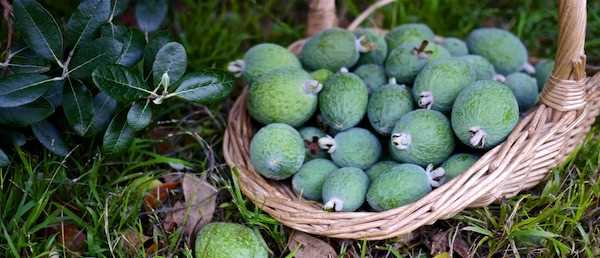

Pruning is an important part of maintaining feijoa trees and ensuring their healthy growth. By removing certain branches and shaping the tree, pruning helps to improve air circulation, sunlight penetration, and overall plant vigor. Pruning also encourages the tree to produce more fruit and helps in controlling its size.
When to Prune Feijoa Trees?
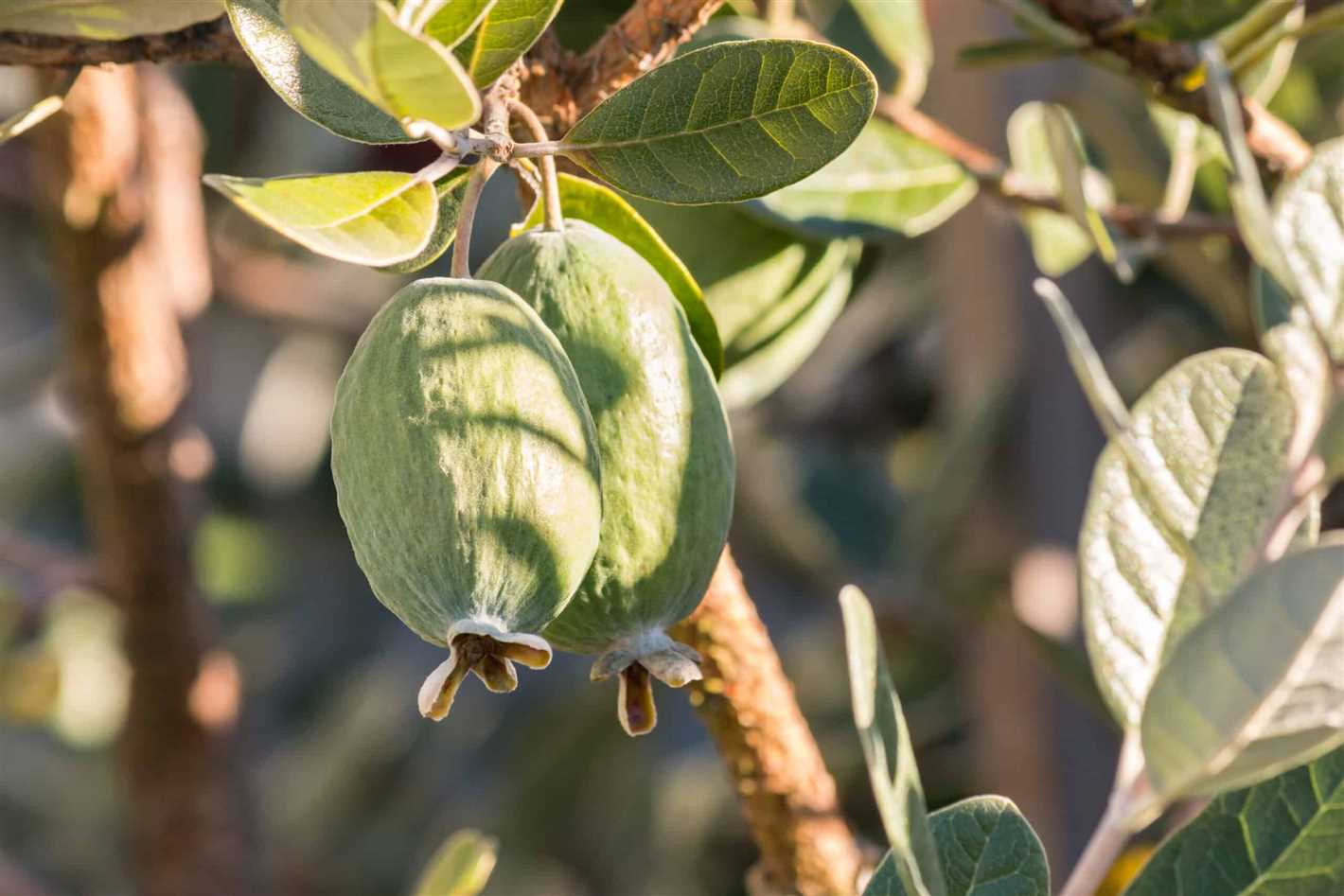

The best time to prune feijoa trees is during late winter or early spring, just before new growth starts. Pruning at this time allows the tree to heal quickly and minimize stress. It is important to avoid pruning during extreme cold or hot weather to prevent damage to the tree.
How to Prune Feijoa Trees?
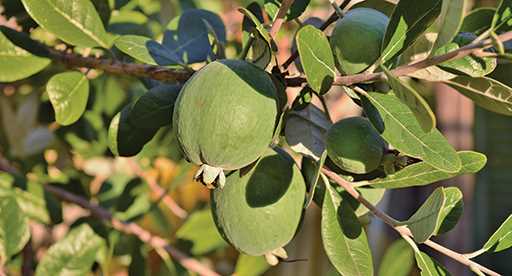

Here are some guidelines to follow when pruning feijoa trees:
- Remove Dead and Diseased Branches: Start by removing any dead, broken, or diseased branches. Cut them back to healthy wood or all the way to the trunk.
- Thin out Overcrowded Branches: Identify branches that are crossing or growing too close together and remove them. This will improve air circulation and sunlight penetration to the center of the tree.
- Control Tree Height: If the feijoa tree is getting too tall, you can prune the top branches to reduce its overall height. This will make it easier to harvest fruits and maintain the tree.
- Shape the Tree: Feijoa trees can be pruned to achieve a desired shape, such as an open vase or a central leader system. Prune the branches accordingly to achieve the desired shape.
- Prune to Encourage Fruit Production: Feijoa trees typically produce fruit on new growth wood. To promote fruiting, selectively prune branches that are not producing well and focus on retaining branches that are healthy and productive.
Tools for Pruning Feijoa Trees
When pruning feijoa trees, it is important to use the right tools to ensure clean cuts and minimize damage:
- Pruning Shears: Use sharp pruning shears for small branches with a diameter of less than 1 inch.
- Loppers: For larger branches with a diameter of 1-2 inches, use loppers.
- Pruning Saw: A pruning saw is needed for thicker branches with a diameter of more than 2 inches.
- Gloves: Wear gloves to protect your hands from cuts and thorns while pruning.
Remember to always disinfect your pruning tools before and after use to prevent the spread of diseases.
Conclusion
Regular pruning is essential for maintaining the health and productivity of feijoa trees. By following the proper pruning techniques and timing, you can ensure optimal growth, fruit production, and a visually appealing tree. However, it is important to be cautious and avoid over-pruning, as this can stress the tree and reduce its vigor.
Soil and Fertilizer Requirements for Feijoa Trees
Feijoa trees require a well-drained soil that is rich in organic matter. The ideal soil pH for feijoas is between 6.0 and 7.0. If your soil is too acidic, you can add lime to raise the pH level.
When planting a feijoa tree, it is important to prepare the soil properly. Dig a hole that is twice as wide and deep as the tree’s root ball. Mix compost or well-rotted manure into the soil to improve its fertility and drainage.
Fertilizing Feijoa Trees
Feijoa trees benefit from regular fertilization to promote healthy growth and fruit production. Here are some guidelines for fertilizing your feijoa trees:
- First Year: In the first year, apply a balanced organic fertilizer with a ratio of 10-10-10. Apply the fertilizer in early spring and again in early summer.
- Second Year: In the second year, reduce the amount of fertilizer by half. Apply a balanced organic fertilizer with a ratio of 10-10-10 in early spring.
- Mature Trees: Once the feijoa tree is mature, you can switch to a low-nitrogen fertilizer with a ratio of 2-8-10. Apply the fertilizer in early spring and again in early summer.
When applying fertilizer, be sure to follow the manufacturer’s instructions for the proper dosage. Over-fertilizing can damage the tree and reduce fruit production.
Additional Tips
Here are some additional tips to keep in mind when it comes to soil and fertilizer requirements for feijoa trees:
- Feijoa trees prefer loamy soil, but they can tolerate a wide range of soil types as long as they are well-drained.
- Adding organic matter, such as compost or well-rotted manure, to the soil will improve its fertility and drainage.
- Mulching around the base of the tree with organic mulch, such as wood chips or straw, will help conserve moisture and suppress weeds.
- Regularly monitor the soil moisture levels and water the tree as needed, especially during dry spells.
By providing the right soil conditions and fertilizing your feijoa trees properly, you can ensure their healthy growth and abundant fruit production.
Watering Feijoa Trees: Finding the Right Balance
Watering is an essential part of caring for feijoa trees. Getting the right balance between too much and too little water is crucial for their health and fruit production. Here are some tips to help you water your feijoa trees effectively:
1. Watering Frequency
Feijoa trees require regular watering, especially during the hotter months. They prefer moist soil but not waterlogged conditions. Aim to water your feijoa trees around once a week, or more frequently during periods of dry weather. Ensure that the soil has a chance to dry out slightly between watering to prevent root rot.
2. Watering Amount
The amount of water needed will depend on the age and size of your feijoa tree. Young, newly planted trees will require less water compared to older, more established trees. Typically, provide enough water to thoroughly moisten the root zone. Water should penetrate at least 8 to 12 inches deep into the soil.
3. Deep Watering
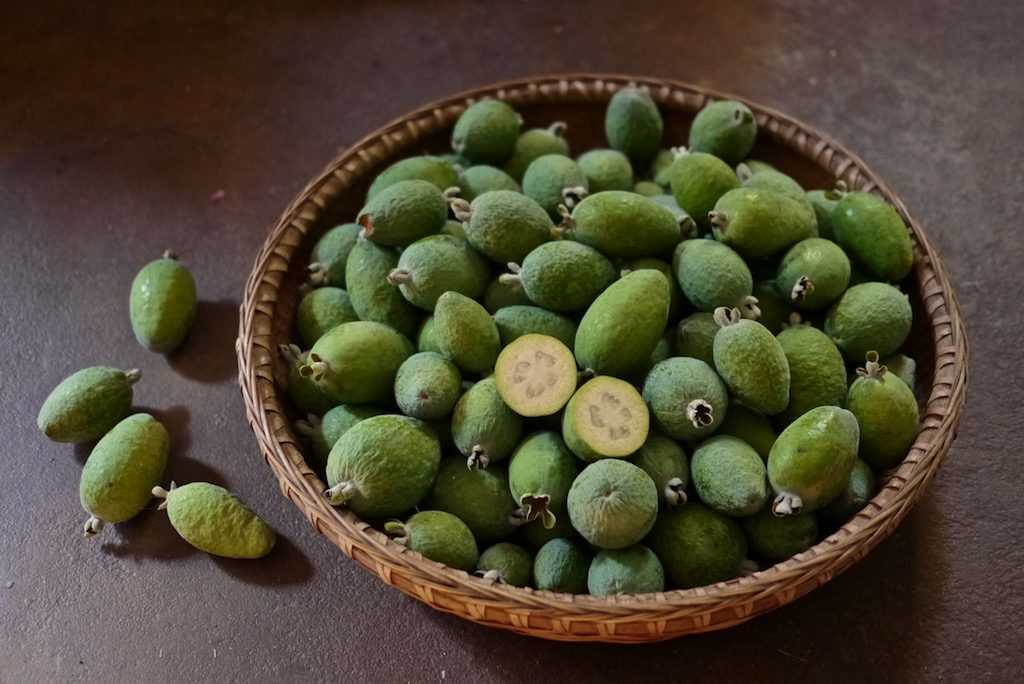

Deep watering is important for feijoa trees as it encourages deep root growth. This helps the tree become more resilient to drought conditions. To achieve deep watering, apply water slowly and evenly around the base of the tree, allowing it to soak into the soil. Avoid wetting the foliage as this can increase the risk of disease.
4. Mulching
Applying mulch around the base of the feijoa tree can help conserve moisture and reduce the need for frequent watering. Place a layer of organic mulch such as wood chips or straw around 2 to 3 inches deep, leaving space around the trunk to prevent rotting. Mulching also helps to control weed growth and regulate soil temperature.
5. Monitoring Soil Moisture
Regularly monitor the moisture level of the soil to ensure you are providing enough water without overwatering. Use a moisture meter or simply dig a small hole with a trowel to check the soil moisture at root level. If the soil feels dry to the touch, it’s time to water. If it feels wet or saturated, you should hold off watering until the soil has had a chance to dry out.
Remember that the water needs of feijoa trees can vary depending on factors such as temperature, rainfall, and soil type. It’s important to observe your trees closely and adjust your watering schedule accordingly to ensure their optimal growth and fruit production.
Protecting Feijoa Trees from Pests and Diseases
Feijoa trees are generally resistant to many pests and diseases, but occasional infestations and infections can occur. Taking preventive measures and regularly inspecting your trees can help keep them healthy and productive.
Pests
Here are some common pests that can affect feijoa trees and how to manage them:
- Fruit Fly: Fruit flies are attracted to ripening fruits. To prevent infestation, remove fallen fruits from the ground and pick any damaged or overripe fruits from the tree. Traps can also be used to capture flies.
- Mites: Mites can cause discoloration and damage to leaves. Regularly inspect the underside of leaves for signs of infestation. If mites are present, spray your tree with an appropriate insecticide or use a horticultural oil to control their population.
- Aphids: Aphids can cluster on leaves, causing them to distort and curl. Introduce natural predators such as ladybugs or lacewings to control aphid populations. If necessary, use insecticidal soap or neem oil to treat heavily infested areas.
- Scale Insects: Scale insects can attach themselves to branches and stems, sucking sap from the tree. Inspect your tree regularly and remove any visible scales with a soft brush or cloth. For severe infestations, use a horticultural oil spray to control the insects.
Diseases
Feijoa trees can be prone to certain diseases. Here are some common diseases and how to manage them:
- Leaf Spot: Leaf spot appears as small, dark spots on leaves. To prevent the spread of the disease, remove infected leaves and prune any affected branches. Regularly apply a copper-based fungicide to protect healthy foliage.
- Root Rot: Root rot is typically caused by overwatering or poorly drained soil. To prevent root rot, ensure your tree is planted in well-draining soil and water it only when necessary. Remove and replace any affected soil, and treat the tree with a fungicide if necessary.
- Twig Dieback: Twig dieback is characterized by the death of young twigs and branches. Prune and dispose of affected branches to prevent the spread of the disease. Ensure your tree is properly watered and fertilized to promote overall health and resilience.
Regularly monitoring your feijoa trees for signs of pests or diseases and taking appropriate action can help ensure their long-term health and productivity. Additionally, maintaining overall tree health through proper pruning, watering, and fertilization can help prevent many issues before they arise.
Harvesting and Storing Feijoa Fruits
Feijoa fruits are typically harvested in autumn when they are fully ripe. The exact harvesting time can vary depending on the climate and the specific variety of feijoa being grown. Here are some guidelines to help you determine when to harvest your feijoa fruits:
- Fruit Color: Feijoa fruits should have a greenish-yellow color with no signs of green or brown patches. The skin should be slightly soft to the touch.
- Smell: Ripe feijoa fruits have a pleasant aroma. If the fruit doesn’t have a strong smell, it may not be fully ripe.
- Taste: The best way to determine if a feijoa fruit is ripe is to taste it. Ripe fruits have a sweet and slightly tangy flavor.
To harvest the feijoa fruits, gently twist and pull them from the tree. Be careful not to damage the fruit or the branch during the process. It’s recommended to wear gloves while harvesting to protect your hands from the sharp leaves of the feijoa tree.
Once the fruits are harvested, they should be stored properly to maintain their freshness and flavor. Here are some tips for storing feijoa fruits:
- Remove Stems: Remove any remaining stems from the fruits before storing them.
- Wash and Dry: Wash the feijoa fruits gently with water and then dry them thoroughly with a clean cloth or paper towel.
- Choose Optimal Storage: Feijoa fruits can be stored at room temperature for a few days if they are fully ripe and you plan to consume them soon. For longer storage, it’s best to store them in the refrigerator.
- Refrigeration: Place the feijoa fruits in a perforated plastic bag or container, and store them in the refrigerator. The ideal temperature for storing feijoa fruits is around 32-40°F (0-4°C).
- Check for Ripeness: Periodically check the stored feijoa fruits for ripeness. If any fruits become overly ripe or show signs of spoilage, remove them to prevent them from affecting the other fruits.
By following these harvesting and storing recommendations, you can enjoy your feijoa fruits for a longer period and ensure that they retain their delicious flavor.
Feijoa Recipes: Delicious Ways to Enjoy Your Harvest
Once you have successfully grown feijoa in your garden, you can start enjoying the delicious fruit it produces. Feijoa has a unique tropical flavor that can be used in a variety of recipes. Here are some delicious ways to enjoy your feijoa harvest:
1. Feijoa Smoothie
Start your day with a refreshing feijoa smoothie. Blend together 2 cups of feijoa pulp, 1 banana, 1 cup of yogurt, and a handful of ice cubes. Add honey or maple syrup to sweeten if desired. Enjoy a healthy and tasty breakfast!
2. Feijoa Jam
Make your own feijoa jam to spread on toast or add to cakes and pastries. In a large saucepan, combine 4 cups of feijoa pulp, 2 cups of sugar, and the juice of 1 lemon. Cook over medium heat until thickened, stirring occasionally. Pour the jam into sterilized jars and seal. Let it cool and enjoy your homemade feijoa jam!
3. Feijoa Chutney
Add a tangy twist to your meals with feijoa chutney. In a saucepan, combine 4 cups of feijoa pulp, 1 cup of brown sugar, 1 chopped onion, 1 cup of raisins, 1 cup of apple cider vinegar, 1 teaspoon of ground ginger, 1 teaspoon of ground cinnamon, and a pinch of salt. Simmer over low heat for about 1 hour, stirring occasionally. Pour the chutney into sterilized jars and let it cool. Serve with cheese or roasted meats.
4. Feijoa Salad
Feijoa adds a unique flavor to salads. Toss together mixed greens, sliced feijoa, crumbled feta cheese, and toasted almonds. Drizzle with a simple vinaigrette made from olive oil, balsamic vinegar, honey, salt, and pepper. Enjoy a light and refreshing feijoa salad as a side dish or a main course.
5. Feijoa Crumble
Feijoa crumble is a perfect fall dessert. In a baking dish, mix together sliced feijoa, brown sugar, and a squeeze of lemon juice. In a separate bowl, combine flour, oats, brown sugar, and softened butter to make the crumble topping. Sprinkle the crumble evenly over the feijoa mixture. Bake in the oven at 375°F for about 30 minutes or until the top is golden brown and the feijoa is soft. Serve with vanilla ice cream or whipped cream.
These are just a few examples of the delicious recipes you can make with feijoa. Get creative and experiment with this versatile fruit to discover your own favorite feijoa dishes!
Q&A:
What is feijoa and where does it originate from?
Feijoa is a fruit that originates from South America, specifically from regions like Brazil and Argentina.
Is it easy to grow feijoa?
Yes, feijoa is relatively easy to grow. It is a hardy plant that can withstand different weather conditions and requires minimal care.
What are the care recommendations for growing feijoa?
Feijoa requires well-draining soil, regular watering, and occasional fertilization. It is also important to prune the plant to maintain its size and shape.
Can feijoa be grown in containers?
Yes, feijoa can be grown in containers, making it a suitable choice for those with limited space. Just make sure the container has good drainage and is large enough to accommodate the plant’s growth.
When is the best time to plant feijoa?
The best time to plant feijoa is in spring when the soil has warmed up. This allows the plant to establish its roots before the colder winter months.
How long does it take for feijoa to bear fruit?
Feijoa typically starts to bear fruit within 2 to 3 years after planting. However, the fruit production can vary depending on factors like the variety, growing conditions, and care provided.
What are some common pests and diseases that affect feijoa?
Some common pests that can affect feijoa include aphids, scale insects, and mealybugs. Diseases like fungal infections and root rot can also be a problem. Regular inspection and proper maintenance can help prevent and manage these issues.
Video:
5 ways to get your Feijoa or Pineapple guava to fruit in the desert!







